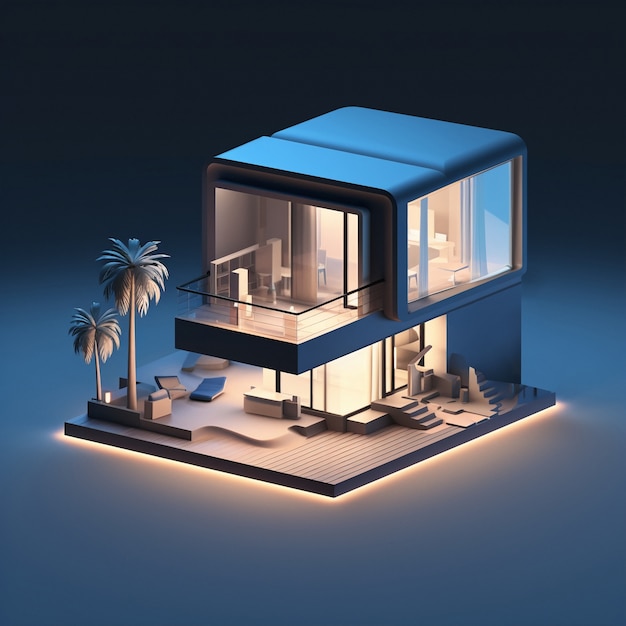
The evolution of design technology has introduced many innovations to the world of interior design. One of the most transformative advancements in the industry is 3D interior rendering. This innovative technique allows designers and clients to visualize proposed spaces with stunning realism and detail. In this article, we will delve into the significance of 3D interior rendering, its benefits, applications, and its impact on the design process.
Understanding 3D Interior Rendering
3D interior rendering is the process of creating photorealistic visualizations of interior spaces. Using specialized software, designers can generate intricate images that depict a room or space before it is constructed. Through this technique, clients gain the ability to see how design elements come together effectively. The potential for transformation lies in how these digital representations can influence design decisions and client satisfaction.
Imagine entering a beautifully rendered virtual room where you can see every detail. The textures, colors, and lighting effects are represented as accurately as possible. This level of realism makes it easier for clients to grasp the intended concept. With 3D interior rendering, the client often becomes more engaged and excited about the design project.
The Benefits of 3D Interior Rendering
One of the primary advantages of utilizing 3D interior rendering is enhanced visualization. Clients no longer have to rely solely on sketches or mood boards, which can sometimes limit understanding. Instead, with dynamic visualizations, clients can perceive the spatial arrangements and overall ambiance much more effectively. This immersive experience empowers them to make informed design decisions that align with their vision.
Additionally, 3D interior rendering facilitates better communication between designers and clients. The visual clarity provided allows designers to convey complex ideas in a digestible manner. This significantly reduces the chances of miscommunication or misunderstandings throughout the design process. As a result, stakeholders can work together collaboratively, refining and adjusting designs in a transparent manner.
Cost and time efficiency is another critical factor that emphasizes the need for 3D interior rendering. Traditional design processes often involved physical mock-ups, which can be costly and time-consuming. By transitioning to a digital rendering strategy, designers can quickly produce visual representations without incurring additional expenses for materials. This efficiency allows for more effective project management.
Applications of 3D Interior Rendering
The applications of 3D interior rendering are diverse and impactful across various sectors. In residential interior design, homeowners can visualize how their spaces will look before any work begins. This greatly enhances the decision-making process regarding furniture placement, color schemes, and material choices. Clients can experiment with different layouts or design styles, obtaining clarity that was once difficult to achieve.
In commercial settings, 3D interior rendering proves equally valuable. Businesses can present visualizations of their office spaces, ensuring alignment with brand identity and functionality. For example, companies can showcase multiple designs to stakeholders, making it easier to secure approvals. This level of precision and insight results in a cohesive design that fulfills the needs of various employees and functions.
3D interior rendering is also essential for marketing purposes. Architects and designers often use these visuals to create compelling portfolios. High-quality renderings can attract potential clients, allowing professionals to showcase their capabilities effectively. Whether for print materials or social media campaigns, 3D renderings amplify visibility, establishing credibility within the industry.
The Impact of 3D Interior Rendering on Client Satisfaction
When clients feel engaged and informed, their satisfaction levels increase significantly. 3D interior rendering enhances this experience, allowing clients to visualize their dream homes or workplaces realistically. By immersing clients in the design process, they develop a deeper emotional connection to the project. This connection reinforces their desire to invest in the proposed design because they see their ideas represented accurately.
Moreover, the interactive nature of 3D rendering supports client feedback. Design iterations become seamless; clients can request changes and see immediate adjustments in real-time. This level of involvement fosters trust between clients and designers. When clients feel heard, they are more likely to be satisfied with the final result.
The Future of 3D Interior Rendering
As technology continues to advance, the future of 3D interior rendering looks promising. The incorporation of augmented and virtual reality technologies enables designers to provide immersive experiences that transcend traditional visualizations. Imagine walking through a virtual space before it exists; clients can explore and interact with designs as if they were physically present. This innovative approach takes client engagement to a whole new level.
Furthermore, the integration of artificial intelligence offers even more exciting possibilities for the design field. AI can assist designers by suggesting materials or layouts tailored to client preferences, streamlining the creative process. With machine learning algorithms, design software can analyze previous projects to predict optimal solutions and enhance overall design quality.
Additionally, the increasing accessibility of powerful rendering software continues to democratize the design process. Small design firms can now create high-quality renderings without significant investments. This shift empowers new talent to enter the market, driving innovation and creativity.
Conclusion
In conclusion, 3D interior rendering is revolutionizing the interior design industry, enhancing visualization, communication, and efficiency. Its numerous benefits and applications make it an invaluable tool for designers and clients alike. By presenting photorealistic representations of spaces, 3D rendering fosters deeper emotional connections and improves client satisfaction throughout the design journey.
As technology advances and evolves, the potential for 3D interior rendering will only continue to grow. Whether through virtual reality, AI integration, or cloud-based software, designers will harness these trends to create even more engaging experiences for their clients. The future of 3D rendering holds limitless possibilities for transforming the way we visualize and experience interior spaces.





